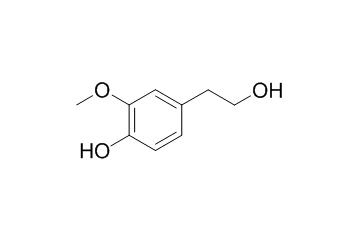Homovanillyl alcohol
Homovanillyl alcohol displays high scavenging activities, it protects red blood cells from hemolysis in a dose-dependent manner. Homovanillyl alcohol has protective effect on cardiovascular disease and total mortality.
Inquire / Order:
manager@chemfaces.com
Technical Inquiries:
service@chemfaces.com
Tel:
+86-27-84237783
Fax:
+86-27-84254680
Address:
1 Building, No. 83, CheCheng Rd., Wuhan Economic and Technological Development Zone, Wuhan, Hubei 430056, PRC
Providing storage is as stated on the product vial and the vial is kept tightly sealed, the product can be stored for up to
24 months(2-8C).
Wherever possible, you should prepare and use solutions on the same day. However, if you need to make up stock solutions in advance, we recommend that you store the solution as aliquots in tightly sealed vials at -20C. Generally, these will be useable for up to two weeks. Before use, and prior to opening the vial we recommend that you allow your product to equilibrate to room temperature for at least 1 hour.
Need more advice on solubility, usage and handling? Please email to: service@chemfaces.com
The packaging of the product may have turned upside down during transportation, resulting in the natural compounds adhering to the neck or cap of the vial. take the vial out of its packaging and gently shake to let the compounds fall to the bottom of the vial. for liquid products, centrifuge at 200-500 RPM to gather the liquid at the bottom of the vial. try to avoid loss or contamination during handling.
J Cell Mol Med.2018, 22(9):4236-4242
Biosci. Rep.2020, 10.1024
J Appl Pharm Sci.2022, 12(04):044-053
Neuropharmacology.2018, 131:68-82
Journal of Applied Pharmaceutical Science2022, 0(00), pp:001-007
Antioxidants (Basel).2022, 11(12):2496.
Industrial Crops and Products2018, 353-362
Int J Mol Sci.2024, 25(20):11227.
J Herbmed Pharmacol.2018, 7(4):280-286
J Immunol.2023, ji2200727.
Related and Featured Products
J Agric Food Chem. 2009 May 13;57(9):3478-82
Olive oil phenolic compounds inhibit homocysteine-induced endothelial cell adhesion regardless of their different antioxidant activity.[Pubmed:
19358606 ]
In this study, we examine the effect of extra virgin olive oil phenolic compounds on homocysteine-induced endothelial dysfunction and whether the protective effects are related to their different scavenging activities.
METHODS AND RESULTS:
Structurally related compounds have been assayed for their ability to reduce homocysteine-induced monocyte adhesion as well as the cell surface expression of intercellular adhesion molecule-1 (ICAM-1) in EA.hy.926 cells. As well-known, among the selected phenolic compounds, hydroxytyrosol, Homovanillyl alcohol, and the hydroxycinnamic acid derivatives caffeic and ferulic acid display high scavenging activities, while tyrosol and p-coumaric acid are poorly active. All of the tested compounds, approaching potential in vivo concentrations, significantly reduce homocysteine-induced cell adhesion and ICAM-1 expression.
CONCLUSIONS:
Interestingly, we report the first evidence that monophenols tyrosol and p-coumaric acid are selectively protective only in homocysteine-activated cells, while they are ineffective in reducing ICAM-1 expression induced by TNFalpha. Finally, we report the synergistic effect of o-diphenolic and monophenolic compounds.
Am J Clin Nutr. 2017 Jun;105(6):1297-1304.
Protective effect of homovanillyl alcohol on cardiovascular disease and total mortality: virgin olive oil, wine, and catechol-methylathion.[Pubmed:
28446500 ]
Background: Hydroxytyrosol is a phenolic compound that is present in virgin olive oil (VOO) and wine. Hydroxytyrosol-related foods have been shown to protect against cardiovascular disease (CVD). We investigated the associations between hydroxytyrosol and its biological metabolite, 3-O-methyl-hydroxytyrosol, also known as Homovanillyl alcohol (HVAL), with CVD and total mortality.
METHODS AND RESULTS:
We included 1851 men and women with a mean ± SD age of 66.8 ± 6 y at high risk of CVD from prospective cohort data. The primary endpoint was a composite of myocardial infarction, stroke, and death from cardiovascular causes; the secondary endpoint was all-cause mortality. Twenty-four-hour urinary hydroxytyrosol and HVAL and catechol-O-methyltransferase (COMT) rs4680 genotypes were measured. After multivariable adjustment, all biomarkers were associated, as a continuous variable, with lower CVD risk, but only HVAL showed a strong inverse association (HR: 0.44; 95% CI: 0.25, 0.80) for the comparison between quintiles. Only HVAL, as a continuous variable, was associated with total mortality (HR: 0.81; 95% CI: 0.70, 0.95). Individuals in the highest quintile of HVAL compared with the lowest had 9.2 (95% CI: 3.5, 20.8) and 6.3 (95% CI: 2.3, 12.1) additional years of life or years free of CVD, respectively, after 65 y. Individuals with the rs4680GG genotype had the highest HVAL concentrations (P = 0.05). There was no association between COMT genotypes and events or interaction between COMT genotypes and HVAL concentrations.
CONCLUSIONS:
We report, for the first time to our knowledge, an independent association between high urinary HVAL concentrations and a lower risk of CVD and total mortality in elderly individuals. VOO and wine consumption and a high metabolic COMT capacity for methylation are key factors for high HVAL concentrations. The association that stems from our results reinforces the benefits of 2 key components of the Mediterranean diet (wine and VOO).
J Agric Food Chem. 2013 Jul 10;61(27):6636-42.
Protective activity of hydroxytyrosol metabolites on erythrocyte oxidative-induced hemolysis.[Pubmed:
23777263 ]
The capacity of important hydroxytyrosol metabolites (Homovanillyl alcohol, hydroxytyrosol acetate, Homovanillyl alcohol acetate, hydroxytyrosol 3' and 4'-O-glucuronides, and Homovanillyl alcohol 4'-O-glucuronide) to protect red blood cells (RBCs) from oxidative injury induced by the radical initiator 2,2'-azo-bis(2-amidinopropane) dihydrochloride (AAPH) or by the natural radical initiator H2O2 was evaluated.
METHODS AND RESULTS:
In the presence of AAPH, all compounds showed to protect RBCs from hemolysis in a dose-dependent manner, exccept for the Homovanillyl alcohol glucuronide, with the order of activity being at 20 μM hydroxytyrosol > hydroxytyrosol glucuronides = hydroxytyrosol acetate = Homovanillyl alcohol = homovanillyl acetate > Homovanillyl alcohol glucuronide. At 10 μM, hydroxytyrosol, hydroxytyrosol acetate, and hydroxytyrosol glucuronides still protected hemoglobine from oxidation and from morphological RBC changes.
CONCLUSIONS:
In the presence of H2O2, hydroxytyrosol showed to significantly protect RBCs from oxidative hemolysis in a dose-dependent manner, but the hydroxytyrosol glucuronides showed only a limited protection that was independent of the concentration used.



